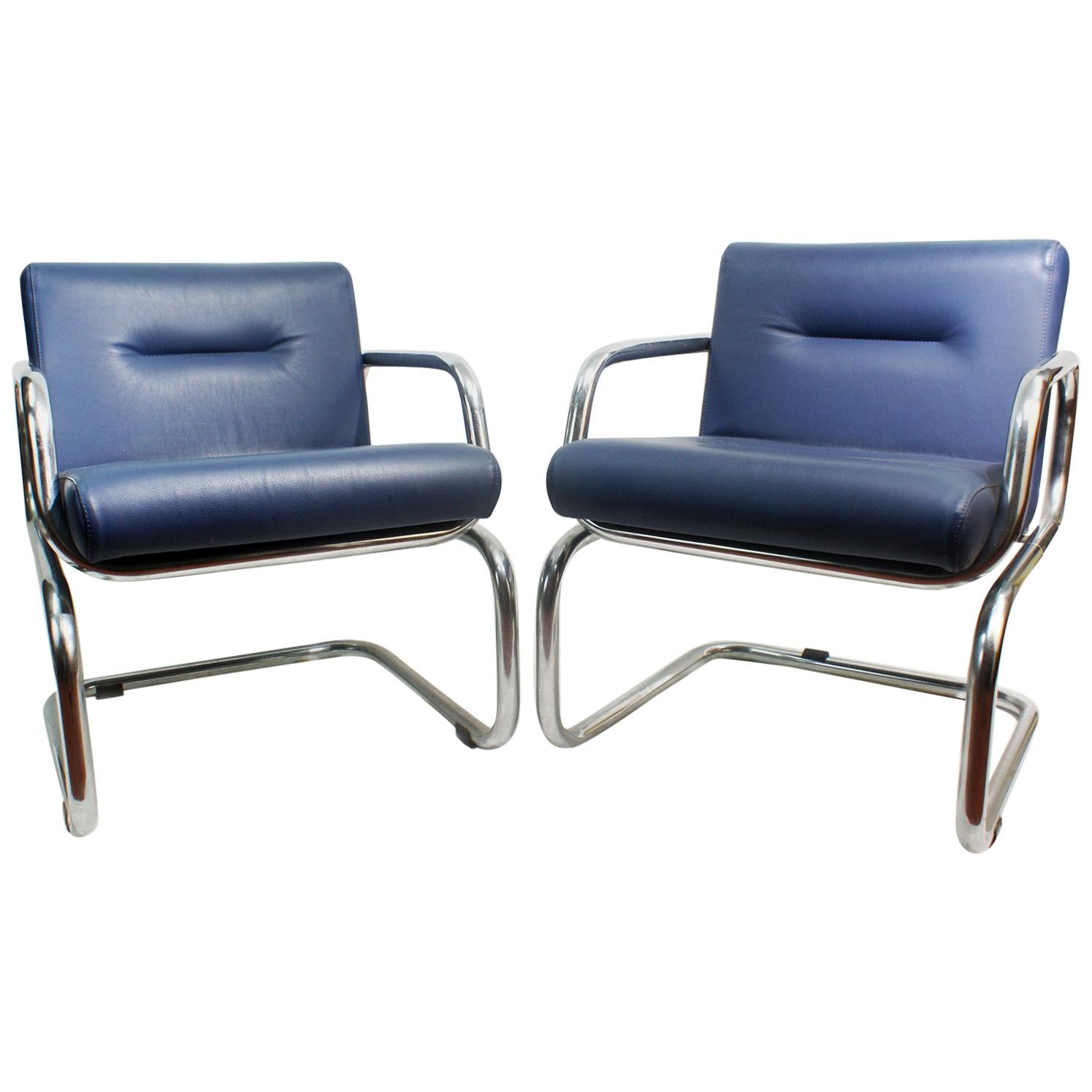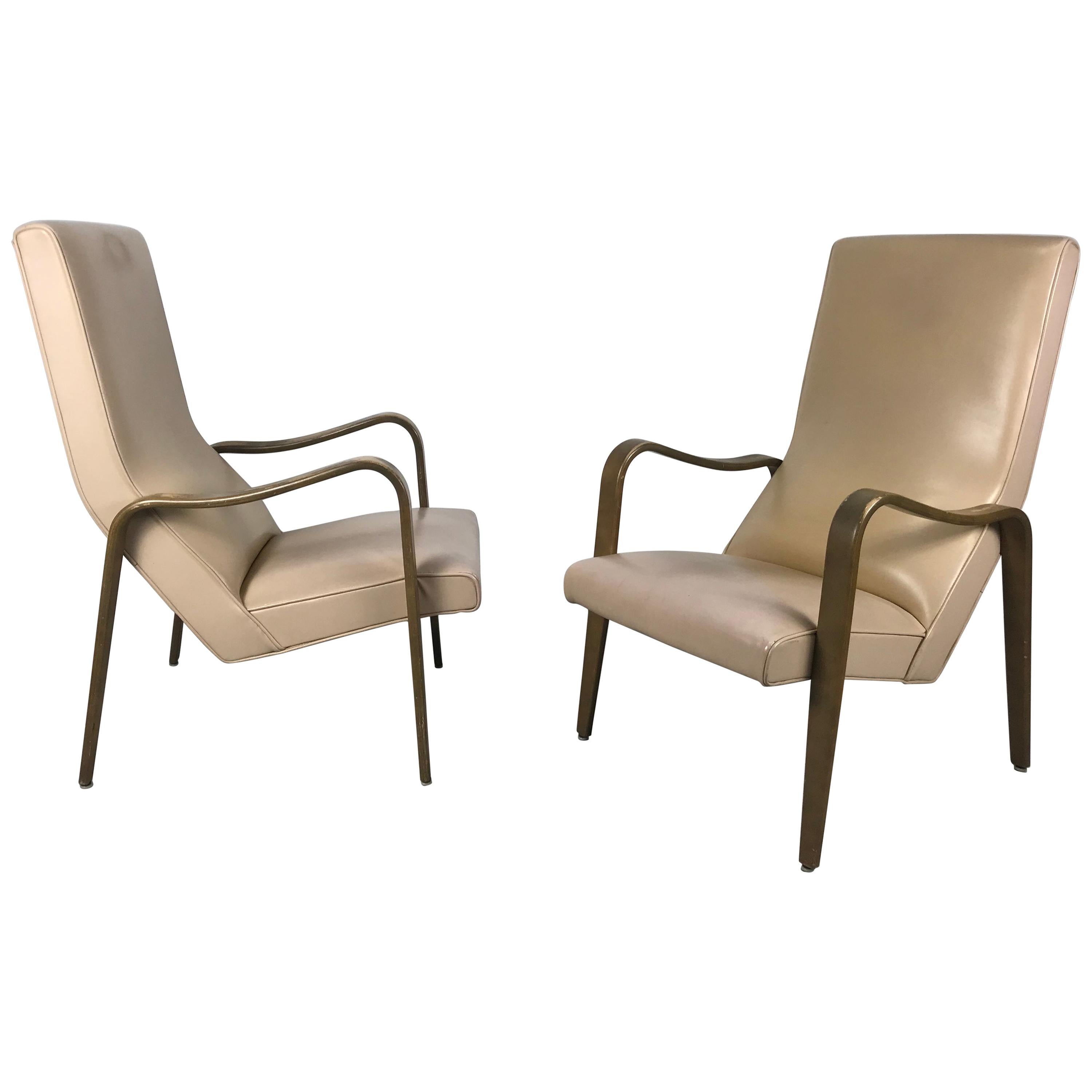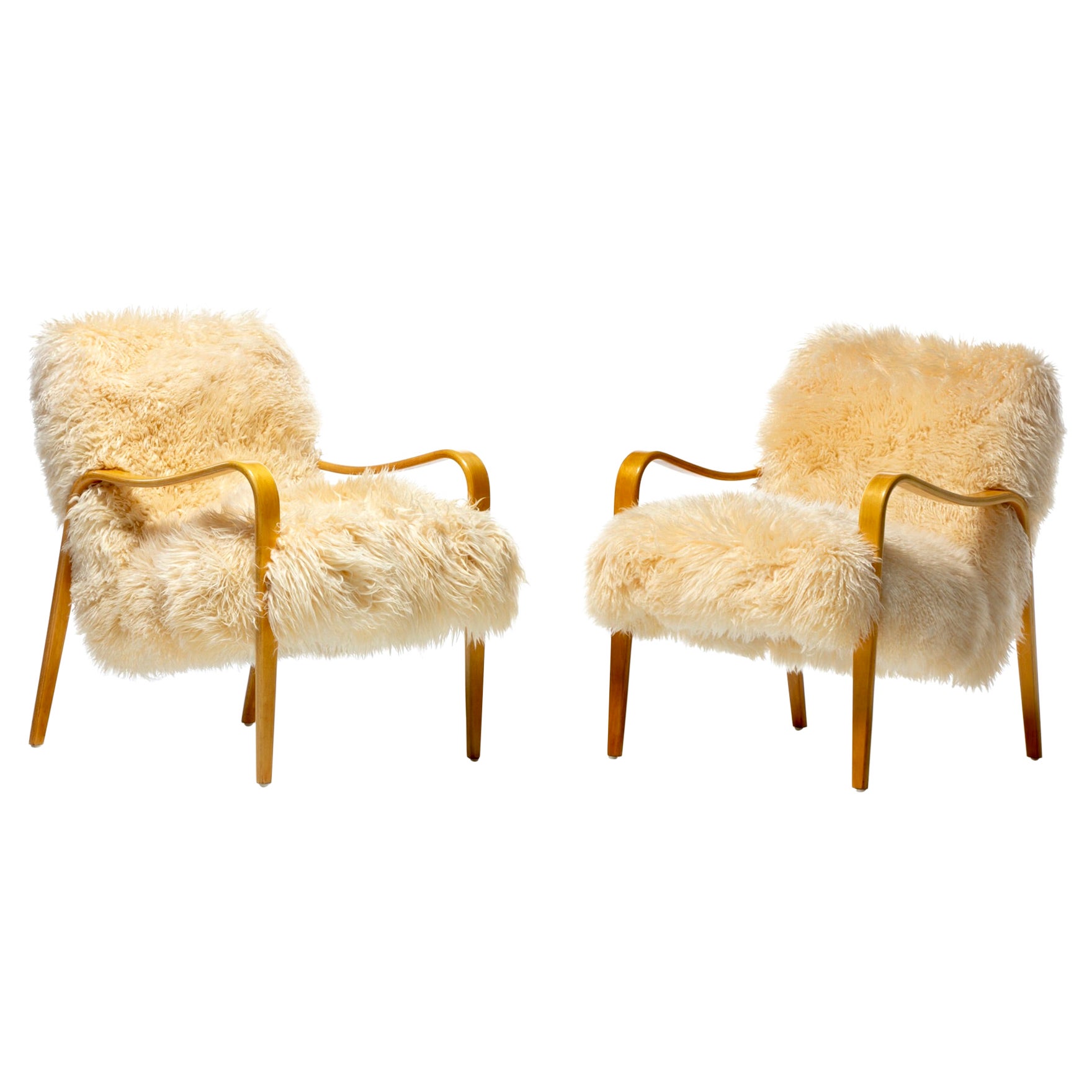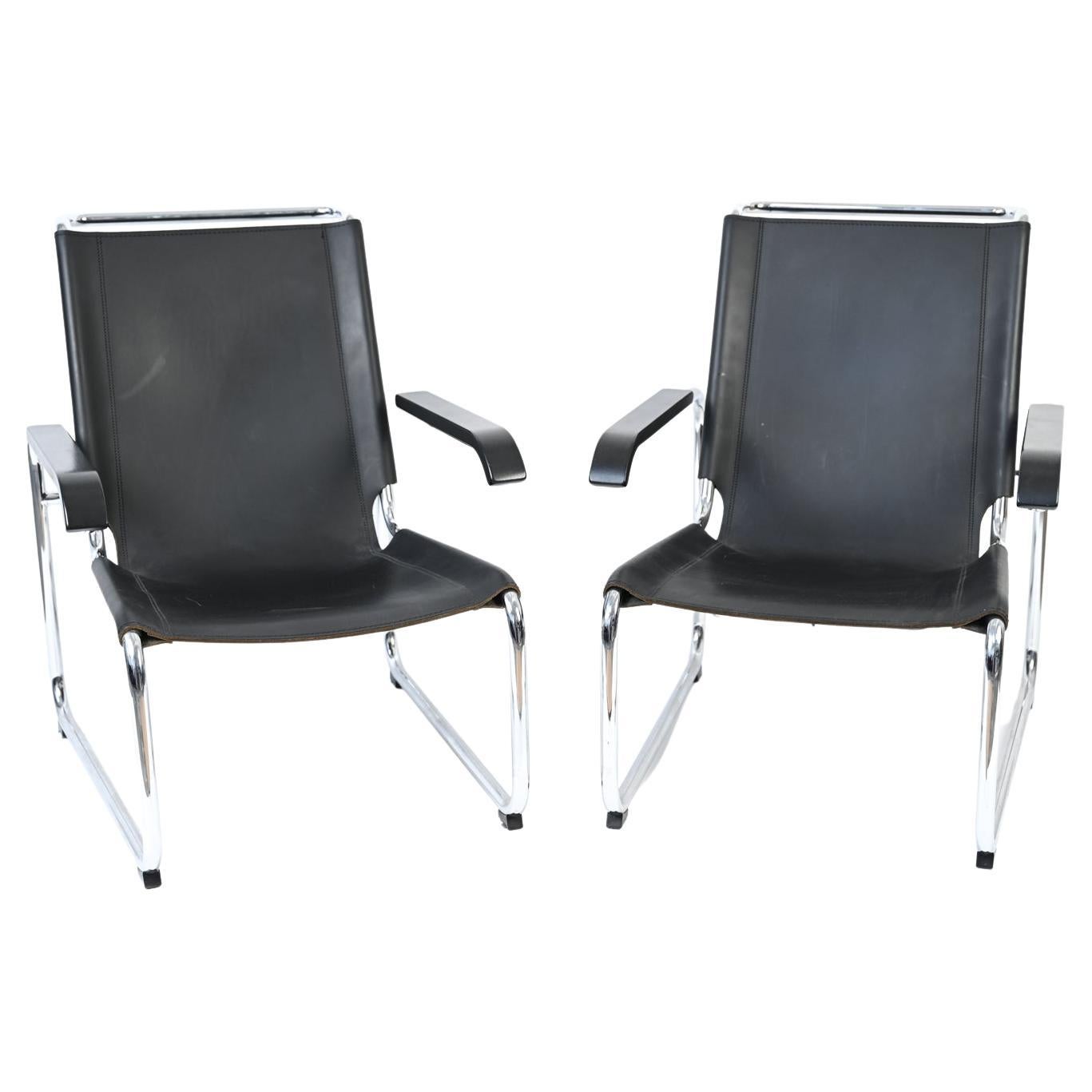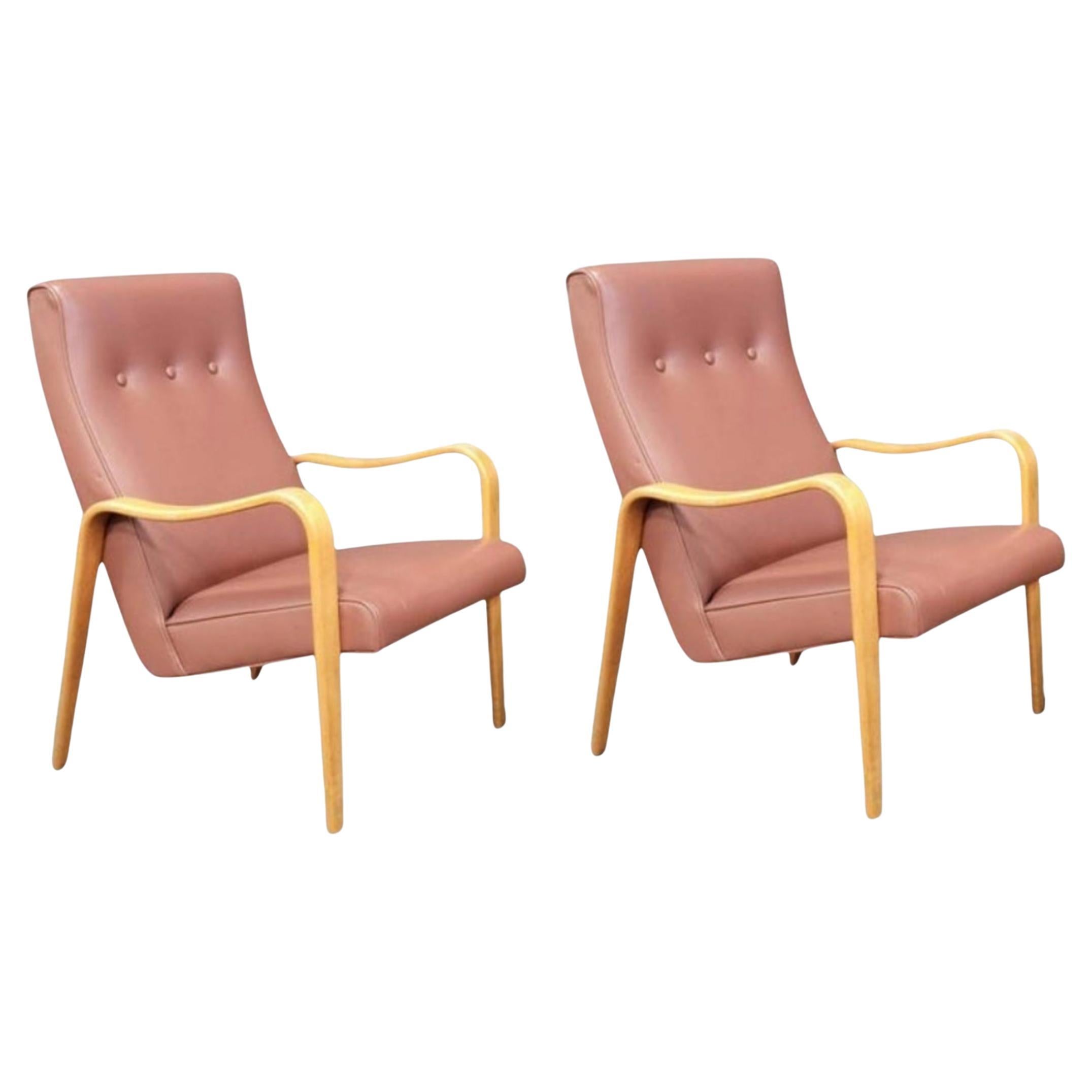Pair Vintage Leather Lounge Chairs by Thonet
About the Item
- Creator:Thonet (Manufacturer)
- Similar to:Pierre Paulin (Designer)
- Dimensions:Height: 30 in (76.2 cm)Width: 31 in (78.74 cm)Depth: 28 in (71.12 cm)Seat Height: 17.5 in (44.45 cm)
- Sold As:Set of 2
- Style:Mid-Century Modern (Of the Period)
- Materials and Techniques:
- Place of Origin:
- Period:
- Date of Manufacture:circa 1960
- Condition:Wear consistent with age and use. Minor structural damages. Minor fading. age appropriate wear, leather worn, some oxidation, upholstery of one chair collapsed, re-upholstery recommended.
- Seller Location:Brooklyn, NY
- Reference Number:
Thonet
For more than 180 years, Thonet — or Gebrüder Thonet — has produced elegant and durable tables and cabinets as well as chairs, stools and other seating that wholly blur the lines between art and design. Widely known as a trailblazer in the use of bentwood in furniture, the European manufacturer has reimagined the places in which we gather.
Noted for his skill in parquetry, German-Austrian company founder Michael Thonet received an invitation from Austrian Chancellor Prince Metternich to contribute Neo-Rococo interiors to the Liechtenstein City Palace in Vienna. The Boppard-born Thonet had honed his carpentry skills in his father’s workshop, where he carried out experiments with plywood and modified the Biedermeier chairs that populated the studio.
Thonet’s work for the chancellor raised his profile, and the cabinetmaker gained international recognition, including at London’s Great Exhibition of 1851, which featured works created by members of the Arts and Crafts movement as well as industrial products of the day. Thonet showed a range of furniture at the fair and won the bronze medal for his bentwood chairs. He incorporated his family’s company, the Thonet Brothers, with his sons in 1853.
Bentwood furniture dates as far back as the Middle Ages, but it is the 19th-century cabinetmaker Thonet who is most often associated with this now-classic technique. Thonet in 1856 patented a method for bending solid wood through the use of steam, and from there, the bentwood look skyrocketed to furniture fame. The works of renowned mid-century modern designers such as Alvar Aalto, Arne Jacobsen, and Charles and Ray Eames that put this technological advancement to use would not be as extensive or celebrated were it not for the efforts of the pioneering Thonet.
Considered the world’s oldest mass-produced chair, Michael Thonet’s ubiquitous Chair No. 14 demonstrated that his patented bentwood technology made it possible to efficiently produce furniture on an industrial scale. Now known as the 214, it won the German Sustainability Award Design for 2021, a recognition of the company’s commitment to environmentally responsible production.
Often called the Coffee House chair — the company’s first substantial order was for a Viennese coffeehouse — the No. 14 remains an icon. Thonet originally designed the chair in 1859, and it is considered the starting point for modern furniture.
The bentwood process opened doors — there were investments in machinery and new industrial processes, and the business began mass-producing furniture. By the end of the 1850s, there were additional Thonet workshops in Eastern Europe and hundreds of employees. Michael Thonet’s reputation attracted the attention of notable architects including Otto Wagner, Marcel Breuer and Ludwig Mies van der Rohe.
The No. 14 was followed by the No. 18, or the Bistro chair, in 1867, and the 209, or the Architect’s chair, of which Le Corbusier was a fan. (The influential Swiss-French architect and designer used Thonet furniture in his Pavillon de l’Esprit Nouveau at the 1925 International Exposition of Decorative Arts in Paris.)
Thonet’s chair designs also appeared in artwork by Toulouse-Lautrec, John Sloan and Henri Matisse in his Interior with a Violin Case. The noteworthy Thonet rocking chair remains a marvel of construction — in the middle of the 19th century, Michael produced a series of rockers in which the different curved parts were integrated into fluid, sinuous wholes. Thanks to Thonet, the humble rocker acquired something unexpected: style. It was captured in the paintings of Pablo Picasso, Pierre-Auguste Renoir and James Tissot.
Thonet is currently split into global divisions. Thonet Industries U.S.A. was acquired in 1987 by Shelby Williams and joined the CF Group in 1999, while the Thonet brand in Germany is owned by Thonet GmbH.
Find a collection of antique Thonet furniture on 1stDibs.
- ShippingRetrieving quote...Ships From: Wall , NJ
- Return PolicyA return for this item may be initiated within 2 days of delivery.
- Vintage Modern Leather Back Lounge ChairLocated in Brooklyn, NYThis unique leather and walnut lounge chair features a sculpted high back seat with tapered walnut legs. Stylish brass sabots and stitched details add to the Mid-Century Modern charm...Category
Mid-20th Century Mid-Century Modern Lounge Chairs
MaterialsFabric
- Pair Danish Leather Lounge ChairsLocated in Brooklyn, NYThis beautiful pair Scandinavian Modern lounge chairs features tufted vintage leather, sleek and slender rosewood frame, and unique Danish design. The comfortable and stylish contour...Category
Vintage 1960s Danish Scandinavian Modern Lounge Chairs
MaterialsLeather, Rosewood
- Pair of Modern Leather Lounge ChairsLocated in Brooklyn, NYThis stylish pair of contemporary modern lounge chairs feature stitched leather upholstery, unique brass finish sculpted frames, and comfortable seating proportions. Elegant midcentu...Category
21st Century and Contemporary Mid-Century Modern Lounge Chairs
MaterialsLeather
- Pair of Vintage Danish Lounge ChairsLocated in Brooklyn, NYGreat pair of comfortable Mid-Century Danish lounge chairs with teak frames and cushioned seats and backs. Please confirm item location (NY or NJ) with dealer.Category
Vintage 1960s Danish Scandinavian Modern Lounge Chairs
MaterialsUpholstery, Wood
- Pair of Vintage Walnut Lounge Chairs by Jens Risom DesignBy Jens RisomLocated in Brooklyn, NYThis stunning pair of Mid-Century Modern arm chairs by Jens Risom Design feature extremely thick padded seating, a floating style backrest, and sculpted arm rests. A sturdy walnut fr...Category
Vintage 1970s American Mid-Century Modern Lounge Chairs
MaterialsUpholstery, Walnut
- Pair of Vintage Modern Winged Arm Lounge ChairsLocated in Brooklyn, NYThis stylish pair of midcentury lounge chairs feature vintage Danish modern design and include sturdy metal legs, winged arm rests, and high back seats upholstered in vinyl. Elegant ...Category
Vintage 1970s Mid-Century Modern Lounge Chairs
- Pair of Cantilever leather Lounge Chairs Manufactured by Thonet in 1980By ThonetLocated in Beirut, LBPair of night blue Bauhaus style lounge chairs on a chromed tubular steel cantilever base, manufactured by Thonet in 1980. Re-upholstered in a night blue leather for the seats and t...Category
Late 20th Century French Bauhaus Armchairs
MaterialsSteel
- Pair of Classic Mid-Century Modern Bentwood Lounge Chairs by ThonetBy T.H. Robsjohn-Gibbings, ThonetLocated in Buffalo, NYPair of Classic Mid-Century Modern bentwood lounge chairs by Thonet, stunning lines, extremely comfortable, rare high back version, retain original finish, well worn finish, leaving ...Category
Vintage 1950s American Mid-Century Modern Lounge Chairs
MaterialsBentwood, Naugahyde
- Pair of Vanilla Creme Sheepskin Lounge Chairs with Bentwood Arms by ThonetBy ThonetLocated in Saint Louis, MOGet cozy in this luxurious pair of Mid-Century Modern bentwood lounge chairs by Thonet circa 1950 freshly reupholstered in vanilla creme sheepskins. Lounge on clouds of soft vanilla creme sheepskins that beckon you to stay awhile...Category
Vintage 1950s American Mid-Century Modern Lounge Chairs
MaterialsSheepskin, Upholstery, Bentwood
- Pair of Contemporary S 35 Lounge Chairs by Marcel Breuer for ThonetBy Marcel Breuer, ThonetLocated in Norwalk, CTThis pair of iconic S 35 lounge chairs features heavy-duty black leather seats slung over tubular polished chrome frames, with black stained beechwood armres...Category
21st Century and Contemporary German Bauhaus Lounge Chairs
MaterialsChrome
- Lounge Chairs in Bentwood and Leather by Christoph Zschocke for Thonet, 1990sBy ThonetLocated in Morazzone, VareseMagnificent pair of very comfortable and strong lounge chairs or armchairs mod. S3001 designed by Christoph Zschocke in 1990s and produced by Thonet...Category
1990s German Bauhaus Lounge Chairs
MaterialsLeather, Beech, Plywood
- Pair of Mid-Century Modern Thonet Bentwood Birch Lounge Arm ChairsBy ThonetLocated in BROOKLYN, NYPair of Mid-Century Modern Thonet bentwood birch lounge arm chairs. Has original medium pastel pinkish vinyl upholstery. Great vintage condition. Timeless chair design by Thonet. Cur...Category
Vintage 1950s American Mid-Century Modern Lounge Chairs
MaterialsUpholstery, Birch, Bentwood
Recently Viewed
View AllRead More
At Château La Coste, Pierre Paulin’s Visionary Home Concept Finally Comes to Life
Now synonymous with 1960s and ’70s French chic, the designer conceived his modular modernist furnishings to change the way we decorate.
Exploring Our Current Obsession with Sixties Style
A new exhibition in Philadelphia stars a complex decade that continues to inspire.
